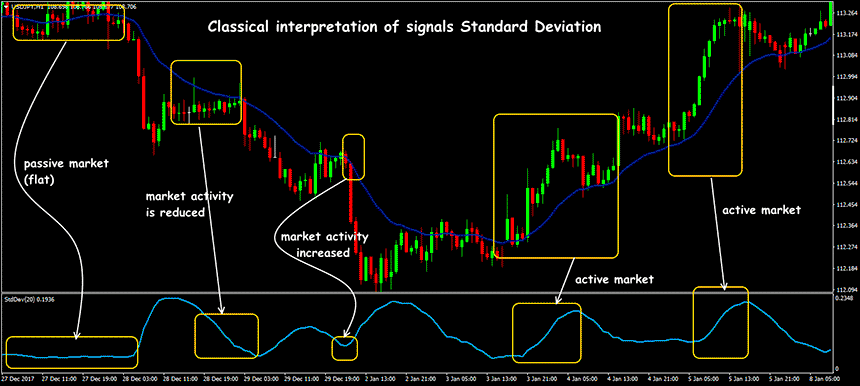
What is Deviation in Forex and How to Interpret It?
The standard deviation indicator, also known as “Standard deviation” (SD), is an indicator that measures price deviations from the moving average. In other words, it is the pricing volatility gauge of deviation in Forex. The standard deviation in Forex is extremely easy to understand and suitable for all investors. It indicates whether the volatility is high or low. This information will help you enter the market at the right time.
What is deviation in Forex trading
So what does deviation mean in Forex? Standard deviation is an essential indicator for traders.
The standard deviation is an indicator that measures the importance of recent movements in the price of an asset in order to predict the volatility of the price action in the future.
It lets a trader know if volatility is likely to rise or fall based on its value.
Indeed, a very high value of the standard deviation indicates that a huge price change has just occurred, this suggests that a drop in volatility could occur in the market or the asset under study.
Conversely, a very low standard deviation indicates the opposite.
This indicator is used for trading currency pairs on the Forex market (Euro, US Dollar, Yen, etc.), crypto-currencies (Bitcoin, Ethereum, Ripple, Litecoin, etc.), commodities (Oil, copper, gold and silver, etc.) ), shares (Total, cap Gemini, etc.) as well as indices (DAX, CAC40, Nasdaq Composite, Dow Jones, S&P, etc.).
Standard deviation in Forex: Definition
The standard deviation is a statistical tool that calculates the dispersion or the spread of a set of values around their mean. The standard deviation is calculated by the square root of the variance. It measures the volatility of an asset. The lower the standard deviation, the more homogeneous the prices.
What is the standard deviation indicator?

Standard Deviation in Forex is a statistical measurement of the volatility, which makes it possible to qualify the dispersion of the courses.
As a reminder, a dispersion indicator measures the variability of the values of a statistical series.
It is always positive, and all the greater as the values of the series are spread out.
The most common are the variance, the standard deviation, or the interquartile range.
These indicators supplement the information provided by the position or central tendency indicators, measured by the mean or the median.
In practice, that is to say, in finance, where an analysis of stock market prices is carried out, this dispersion is estimated by the standard deviation.
In technical analysis, the standard deviation must be used in addition to another indicator.
Formula or calculation method for the standard deviation indicator
The standard deviation formula can be simplified as follows: Standard deviation= Square root[Sum of n(closing -Simple moving average over n closing)²/n]
Interpretation of the standard deviation indicator in trading
Standard deviation is the statistical measure of market volatility, which measures the deviation between prices and the average price.
If the prices are trading in a narrow range, the standard deviation will give a low value and indicate low volatility.
Conversely, if the prices fluctuate strongly up and down, then the standard deviation returns a high value which indicates high volatility.
The standard deviation generally makes it possible to anticipate the violent movements that can be detected as soon as low volatility materializes.
Indeed, empirically we can see that violent movements are often preceded by low volatility.
How to use standard deviation in Forex trading
The standard deviation indicator is included in the default indicator set of MetaTrader. Go to “Insert > Indicators > Trend,” and you will see “Standard Deviation.”
The default period is 20 and is applied by default for “Close” (closing price of each bar). If you increase the period, the indicator line will be much smoother and will produce extremely high or low readings much less often.
If you reduce the period, the SD line will hit extreme market tops and lows more frequently. This way, you will get more trading signals.
At the same time, more of these signals will be false. Therefore, you may need to experiment and adjust the indicator settings to match the trading instruments you are using as well as the volatility. In general, the standard setting of 20 is considered the most reliable.
How to interpret it standard deviation in Forex
The standard deviation indicator shows the range of price changes relative to the moving average. If the value of the indicator increases, the market is volatile, and the price fluctuations are rather scattered with respect to the moving average.
If the value of the indicator is small, it means that the market volatility is low and the price remains close to the moving average.
Traders need to know that periods of market activity and calm generally alternate, and the price tends to return to its average level each time:
– The increase in the standard deviation line indicates high volatility because the closing price and the average closing price differ significantly. Extreme highs in the standard deviation warn that the current activity will soon subside and be followed by a period of consolidation.
– The decline of the standard deviation line indicates low volatility, and the market is inactive (prices are stable). Extreme standard deviation lows could signal the market’s next move.
Additionally, the current value of the standard deviation can be used to estimate the magnitude of a price move. A move greater than one standard deviation would indicate above-average market strength or weakness, depending on the direction of the move.
Standard deviation is often used with other more sophisticated indicators, such as Bollinger Bands. These bands are set 2 standard deviations above and below a moving average. Learn more about Bollinger Bands here.
Overall, the standard deviation indicator can help you accomplish the following things:
Choose important highs or lows in the market (you should look for very volatile prices that have risen too far from the average).
Target entries in trends (if the trend is strong, you can target the entry at the average price, i.e., when the standard deviation is low). If prices are trading in a narrow range and the suddenly high standard deviation pushes prices away from the mean, you can deal with the breakout.
How to configure standard deviation in your trading software?
If you decide to experiment with different settings for the standard deviation indicator, it is essential that you ensure that any changes made have a positive impact on your currency trading results.
Changing the Standard Deviation Indicator Settings
In most trading platforms such as Metatrader MT4, MT5, or Trader Workstation, the standard indicator setting is 20.
This is the number of periods over which the indicator calculates the deviation.
Thus, on a daily chart, your trading platform calculates the standard deviation over the last 20 days.
If you change the indicator setting to be above 20, it will be less sensitive.
Conversely, if you set this value to less than 20, it will make it more sensitive.
Trading strategy with the standard deviation indicator on the stock market
There are several strategies that can be used with this indicator, including the most popular ones, such as the support and resistance strategies that are based on standard deviation spikes or the standard deviation high rise after low. value of it.
The strategy of supports and resistances and peaks on the standard deviation
We place a buy position when a resistance is broken, and at the same time, a bearish peak materializes on the indicator.
Conversely, we pass a sell position when a support is broken, and at the same time, a bearish peak materializes on the indicator.
The strategy of supports and resistances and a low standard deviation
This strategy consists, first of all, in identifying lines of support and resistance.
Then, it is necessary to position yourself to buy on supports or to sell on resistances when the value of the standard deviation progresses strongly after a long period of calm, as shown in the graph below.
The advantages of the standard deviation indicator

For example, if the price has risen sharply or fallen too low compared to its average, statistically, it is very likely that it will return to its average price.
Identifying this type of movement and taking a position with a calculated risk is a profitable strategy to earn a few pips in the Forex market.
You can also trade the breakout of a range or consolidation pattern when prices move within a very narrow price range, and the value of the standard deviation is low.
It will then be very interesting to enter a position when prices suddenly break out of the price band or range, which leads to a jump in the standard deviation and a strong price change.
The disadvantages of the standard deviation indicator

Its value simply makes it possible to measure via a data set an excess of prices in relation to an average price.
Therefore, it will always be necessary to use this type of tools with a trend indicator or graphic configurations such as supports and resistances or figures such as the head and shoulders chart.
Conclusion – What is Deviation in Forex
Standard deviation is an indicator that measures the volatility of an asset’s price to predict the magnitude of future movements; it appears on charts as a line just below the price chart.
Generally, high value of the standard deviation means that a strong price movement has just occurred, but a decrease in volatility may soon follow.
Conversely, a low standard deviation means volatility is low, but a big price move could soon follow.
The standard deviation indicator only helps predict the size of upcoming price movements but not their direction.
The standard setting of the indicator is 20, which means that it calculates the deviation of the last 20 sessions. Using a setting above 20 will make the indicator less sensitive.
A setting below 20 will make the indicator more sensitive.The standard setting of 20 is considered the most reliable by most traders.




